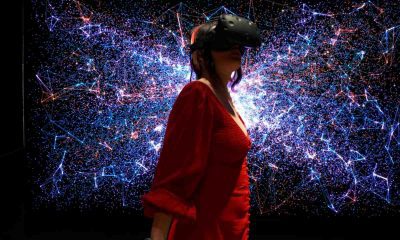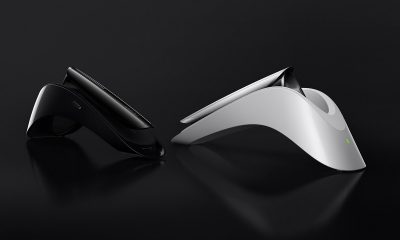Technology
Top 10 Business Intelligence Tools For Strategic Decision-Making
Published
3 years agoon

Are you looking for a reliable business intelligence tool? Fret not. Here are the top 10 business intelligence tools to help you in strategic decision-making. Compare the features and choose the best platform that fits your needs.
1. MicroStrategy
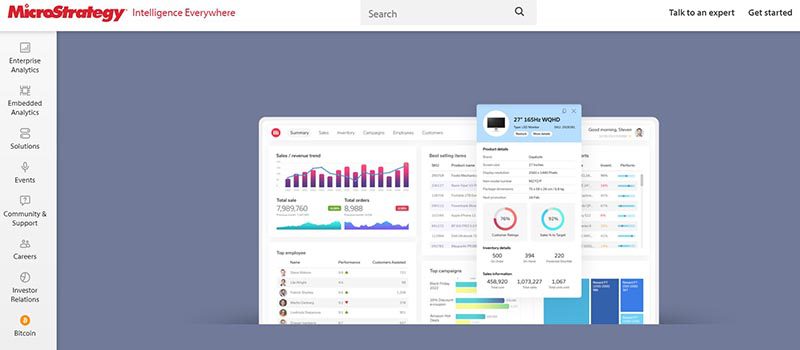
MicroStrategy is a pioneer in business intelligence (BI) that provides robust dashboarding and analytics, cloud solutions, and hyperintelligence. This software allows users to identify trends, discover opportunities, and improve productivity. Besides that, it is accessible on desktop or via mobile.
Features:
- Users can connect to one or more sources, whether data is coming from spreadsheets, cloud-based, or enterprise data software.
- Customizable templates
- Real-time reporting
- Works both on desktop or via mobile
2. SAS Business Intelligence

SAS Institute is an American multinational developer of innovative analytics that also offers an excellent business intelligence tool. It was established in the 1970s and has been helping users make informed decisions. SAS BI tool’s top-notch analytics give more contextual insights into your data.
Features:
- Data visualization
- Generate meaningful insights
- Real-time dashboards and reporting
- Collaboration
- Mobile BI App
3. Datapine

Datapine is a highly-recommended platform for those looking for comprehensive self-service analytics. Datapine’s solution facilitates complex data analytics processes for non-technical users.
Features:
- Easy integration from various sources
- Advanced data analysis
- Interactive dashboards
- Realistic business insights
4. SAP Business Objects
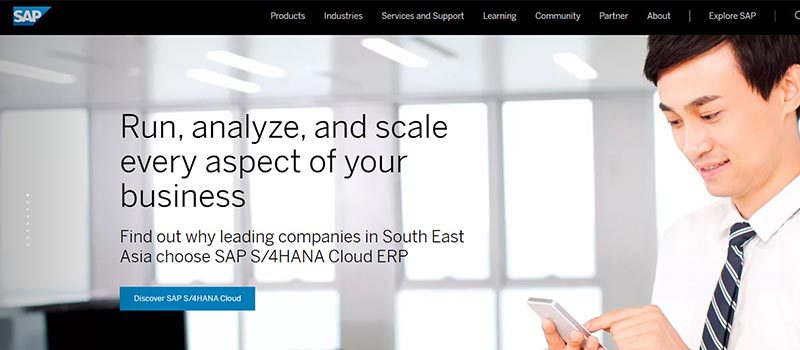
SAP Business Objects offers a comprehensive analysis, reporting, and interactive data visualization. The software offers expert solutions for customer experience, CRM, digital supply chain, and enterprise accounting. Also, SAP Business Objects will enable users to create their own dashboards and applications.
Features:
- Explore, report, and share all in a single, integrated offering
- Powerful search and browse functions
- Mobile BI App
- Customizable templates
- Ad hoc reporting
- On-time reporting
- Intuitive interface
5. Yellowfin BI
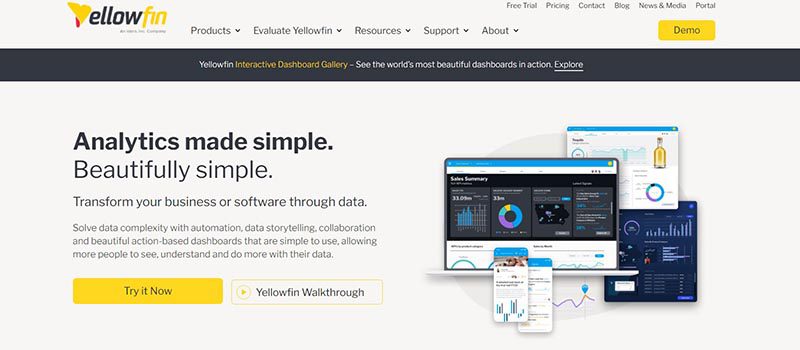
Aside from being a business intelligence tool, Yellowfin BI is an ‘end-to-end’ analytics platform. Yellowfin BI combines machine learning, visualization, and collaboration. This way, users can efficiently filter large volumes of data with an intuitive filtering function. Plus, they can access the dashboards just about anywhere.
Features:
- Interactive dashboards and reports
- Self-service analytics
- Advanced analytics
- Data visualization
6. QlikSense
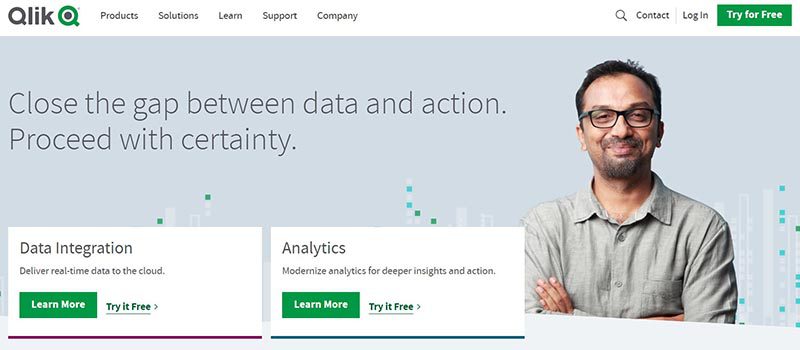
QlikSense is an integrated data analytics platform and business intelligence tool. The user interface of QlikSense is optimized for touchscreen. Search & Conversational Analytics is one of the exciting features of QlikSense. Moreover, it allows more efficient handling of queries and discovering new insights through natural language.
Features:
- Self-service analytics
- Data visualization
- Conversational analytics
- Custom and embedded analytics
- Mobile BI
- BI reporting
- Augmented analytics
7. Zoho Analytics
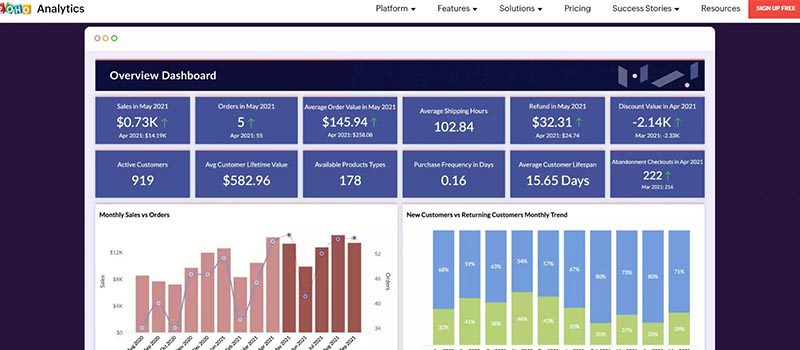
Zoho Analytics is a valuable BI tool for data analysis and in-depth reporting. This tool has automatic data syncing and can be scheduled regularly. Likewise, Zoho’s quick-access editor helps you make personalized reports and dashboards.
Features:
- Data integration
- Data preparation and management
- Data storytelling
- Visual analysis
- Augmented analytics
8. Microsoft Power BI
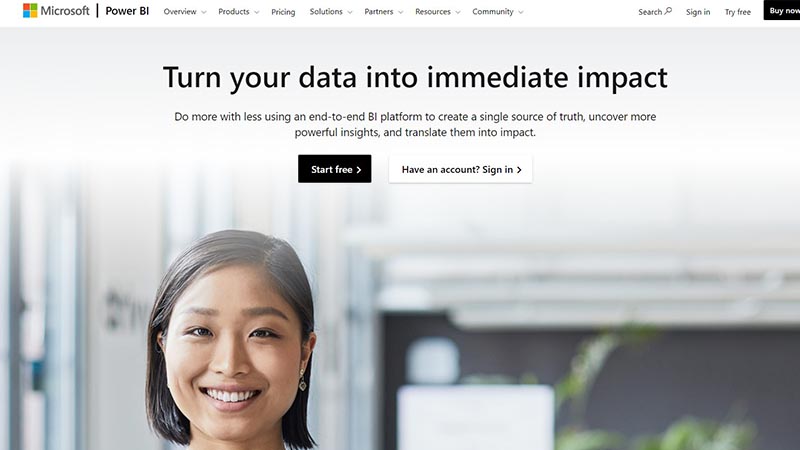
Microsoft Power BI is an online business analytics platform that excels in data visualization. The platform helps you identify trends in real time. Its brand-new connectors enable you to enhance your campaigns. In addition, Power BI lets you integrate apps, deliver reports, and explore real-time dashboards.
Features:
- Can provide business intelligence for all
- Interactivity of data
- Easily connects to many data sources
- Has AI capabilities
- Secure
9. Tableau
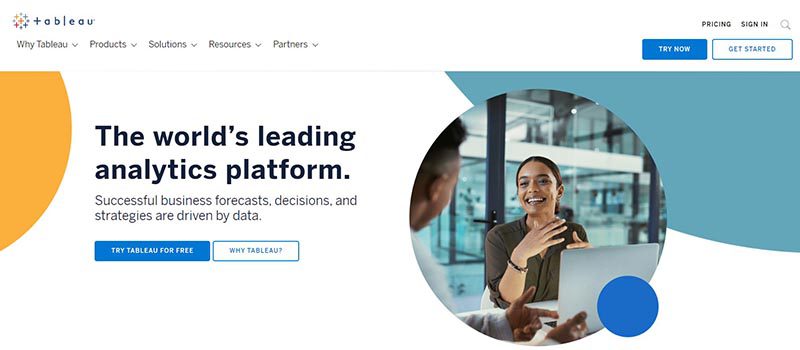
Tableau is another business intelligence tool with a focus on data visualization. With the software, you can quickly analyze, visualize and share data without complicated IT intervention. Tableau works well with multiple data sources, including MS Excel, MS SQL, Google Analytics, SalesForce, and Oracle.
Features:
- Data blending
- It does not require in-depth technical knowledge
- Real-time analysis
- Data collaboration and data notifications
- Dashboards commenting and sharing
- Mobile-ready dashboards
- Create “no-code” data queries
- Import all ranges and sizes of data
10. Oracle BI
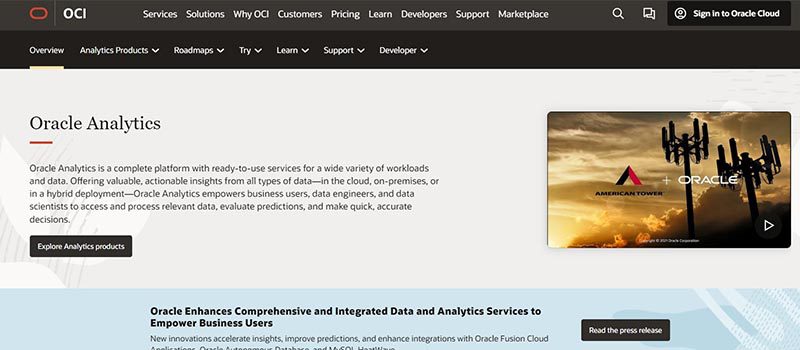
Oracle BI is an enterprise business intelligence that allows users access to dashboards, proactive intelligence, ad hoc, and more. Oracle is also great for companies that analyze extensive data. Its key features include data archiving, versioning, a self-service portal, and notifications.
Features:
- Performance management apps
- Business intelligence foundation
- Data warehousing
- Servers and storage systems
- Performance management applications
- BI applications
Benefits of Business Intelligence Tools
Integrated BI software and tools have many benefits. Below are the essential ones:
- They consolidate all relevant data. Small and large companies collect data from various sources, files, databases, and software. Business intelligence tools help identify issues and trends based on data.
- Their self-service analytics modalities unlock data access. Redundant tasks from the IT department are significantly reduced when staff uses business intelligence tools.
- Users can benefit from forecasts. Users can efficiently generate insights for future scenarios through predictive analytics integration. Also, BI tools help adjust your current strategies to achieve optimal results.
- They eliminate manual tasks. Modern software eliminates endless rows and columns in spreadsheets and facilitates the automation of processes. Additionally, business intelligence tools update your KPI dashboard itself with real-time data.
- They reduce business operation costs. It enables faster planning, analysis, and reporting processes, saving companies time and money.
- They’re always accessible. Various organizations have several needs, and the Software-as-a-Service model offered by these tools will provide a complete SaaS BI experience, with all the data hosted in a secure online environment.
Conclusion
Business intelligence tools allow you to understand the latest trends and derive insights from your data for decision-making. The predictive analysis approach identifies data patterns your company has collected over time. Besides, the reason for compiling these tools is to compare the features of BI tools and guide you in selecting what works best for your organization.
You may like
Technology
Oppo Air Glass: A Ground-Breaking AR Technology Experiment?
Published
14 hours agoon
August 14, 2025
On March 3, 2022, Oppo launched its first-generation Air Glass, a monocle-style Augmented Reality (AR) device designed to pair with Oppo smartphones. The Air Glass featured a lightweight design (just 30 grams), a microLED display with up to 1400 nits brightness, and supported functions like navigation, real-time translation, calendar reminders, and teleprompter mode. Despite its futuristic appeal, Oppo released it only in limited quantities within China, with no plans for international availability. Priced at 4,999 yuan (around $745), the Air Glass was more of a conceptual showcase than a consumer-ready product, aimed at demonstrating Oppo’s vision for assisted reality.
Main Features
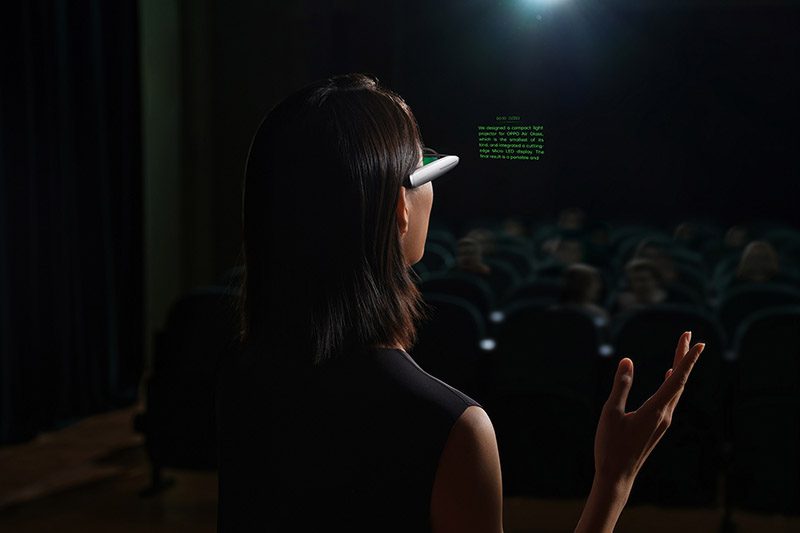
While many AR experiments focus on pushing purely technical capability, the Oppo Air Glass accepts some clear hardware limitations to play with an exciting form factor. Adi Robertson of The Verge tested a set of glasses and a matching smartphone. Robertson found a design idea so obvious and still needs more improvement.
Augment Reality is a spectrum, and the Air Glass is considered a “simple notification machine” aspect. It differs from those realistic holograms in products such as Microsoft HoloLens.
Below are some of the noticeable features of Oppo Air Glass:
- The device is a single lens with a microLED display. The display can have a staggering peak brightness of up to 1400 nits!
- The powerful Spark Micro Projector shows all the dual Sapphire crystal glass information.
- Oppo Air Glass is powered by Qualcomm’s Snapdragon Wear 4100 SoC.
- This innovative device is equipped with Wi-Fi, Bluetooth, and GPS with in-built speakers and microphone.
- This device can turn into a mini teleprompter. Since the teleprompter displays any text you want, you can use it more creatively.
- Currently, automatic translation is still limited to English and Chinese.
When you pair the smart device over Bluetooth with a China-only Oppo smartphone, you’ll see a green heads-up display that covers a tiny but significant portion of your vision. But Robertson said she was amazed by the assumption behind Oppo’s design. It is because it’s a solid idea to offer lots of style options while mitigating the usual AR creepiness.
Nine years ago, Google Glass conducted a similar experiment. They invented the expensive camera and projection system and let them wear them at all times. But it looked awkward.
Other Specs and Features
Oppo’s AR interface relies on widget-like applications in the form of “cards,” which the wearer can manage from the paired smartphone application. It can be controlled using a touchpad on its side. Hand gestures are also supported, as is the peculiar feature of using the motion of the head to control it. Moreover, voice control is also incorporated.
Meanwhile, the Air Glass looks like an earbud for your eyes. Oppo Air Glass weighs only 30 grams, making it incredibly lightweight to wear. Users can wear it over their frames, but only two specific sizes exist.
It’s a product that takes people’s concerns about privacy and distraction seriously instead of trying to hide what they’re worried about inside a smaller package. It also helps that this version of Air Glass doesn’t have to include a camera. But Oppo says it doesn’t rule the option out for future versions.
“Unfortunately, after my first few hours with the glasses, I became slightly motion-sick and developed a headache within minutes of putting them on. The discomfort seemed to improve over time, but my eyes still feel strained after wearing them”, says Robertson.
Since then, Oppo has continued refining its AR ambitions, culminating in the Air Glass 3 prototype revealed in 2024, which integrates AI capabilities and a more natural eyewear form factor.
Technology
Augmented Reality Contact Lenses: A Breakthrough in AR
Published
14 hours agoon
August 14, 2025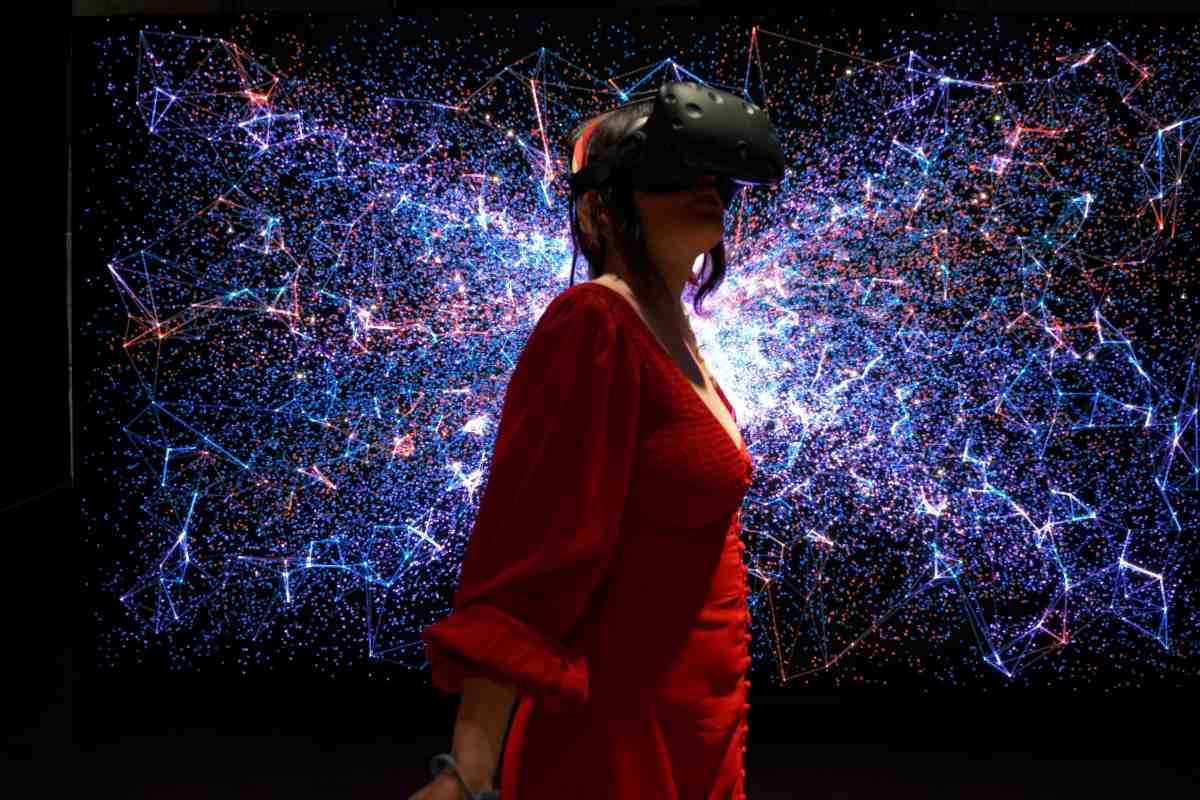
About three decades ago, scientists at Air Force Research Laboratory (AFRL) worked with a group of human volunteers to try something never before done. They were tested for a prototype augmented reality system that allows them to engage with virtual objects that will be merged with the real world. The test subjects were asked to perform several tasks, including climbing an exoskeleton, pressing their faces against a vision system, and interacting manually with a blend of real and virtual objects.
This system cost around $1 million to build, but had become a resounding success. It only filled the room by half, demonstrating for the first time that AR technology works. It has been proven to enhance human performance in real-world functions.
Then, a few years ago, the breakthrough was achieved in a research lab at Mojo Vision in Saratoga, California. It featured the achievements of the field over the past decades. This time, it’s about an augmented reality contact lens. The research was a genuine test of an AR contact lens that the users wear directly on the eyes.
Big in Power, Small in Space
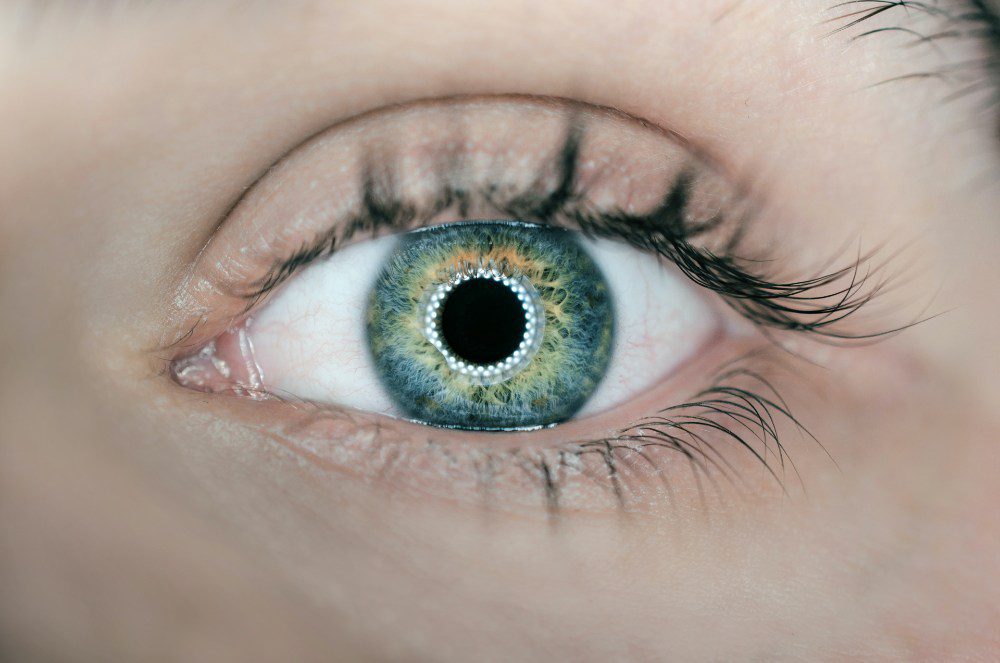
Augmented reality contact lenses are a challenging endeavor, according to experts. People generally focus on the display technology when in fact, it is more than that. Putting a high-resolution display on a tiny, transparent lens is no small feat, but it is the most straightforward task.
The more complicated part was making the tiny lens sit comfortably on the human eye. It also has to communicate wirelessly with the external devices without any kind of string attached. However hard it was, this was the exact result that Mojo Vision accomplished.
Augmented Reality Contact Lenses
According to Mojo Vision, the contact lens called Mojo Lens has a 14,000 pixel-per-inch microLED display with a pixel pitch of 1.8 microns. Compared side-by-side with an iPhone 13, the Mojo Lens has 30 times its pixel density. The iPhone only has 460 pixels per inch with its Super Retina XDR Display.
Furthermore, the lens has an ARM processor, a 5GHz radio transmitter, an accelerometer, a gyroscope, and a magnetometer for eye movement monitoring. All these technologies will sit on the human eye.
But these aren’t the most intricate parts yet. The biggest challenge was how they would incorporate power into the lenses. Mojo Vision tells us that the Mojo Lens has medical-grade micro batteries. The company hasn’t given out details of the battery life yet, but they let us know that they aim to provide power management that enables users to wear the lenses throughout the day.
Augmented Reality is the Future
Indeed, this is a promising prospect, but one that will take more time to be fully developed. Making it as low-cost as possible for everyone to enjoy will be a long journey, but it is where it is headed. It is predicted that AR eyewear, from glasses to contacts, will take the place of mobile phones as the main interface of digital content within the next decade.
This also means that AR technology will impact society significantly. It will change digital assets into seamless features of our physical surroundings. The past decades have shown us that life with augmented reality will become mainstream. People will soon get fitted for new contact lenses when they sign up for a mobile subscription.
In addition, given the impressive innovations in engineering, it is reasonable to expect that AR will replace mobile phones as the new platform of our daily lives in the years to come. Currently, the prospects are still a matter of suggestions, and only time can tell.
And for other stories and news, read more here at Owner’s Mag!
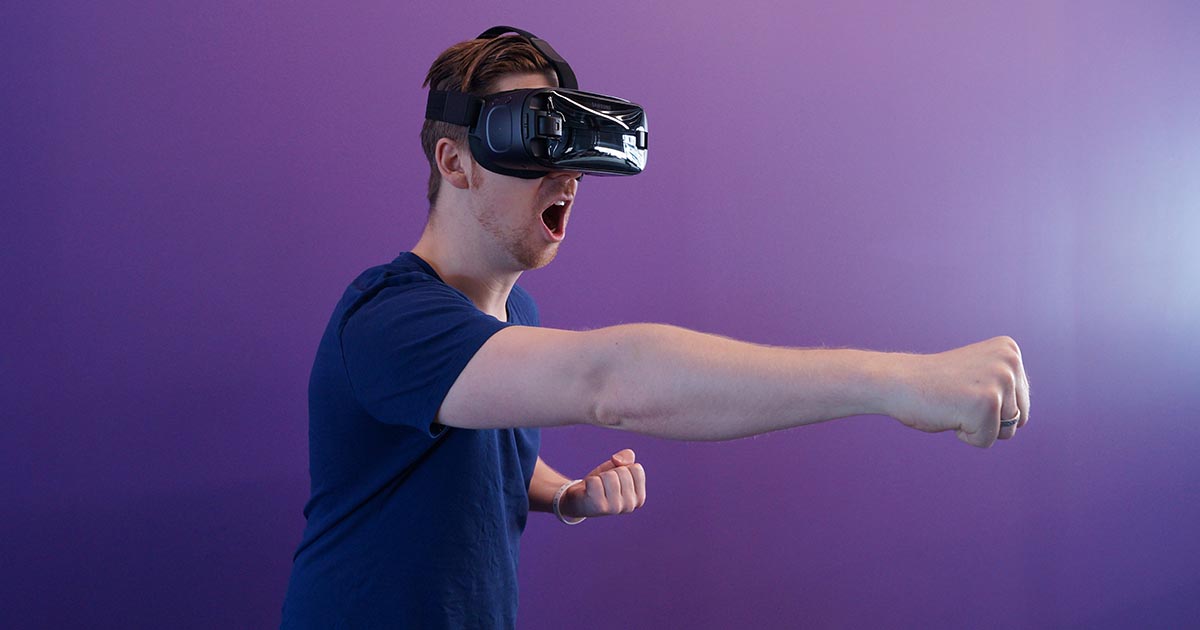
Ever felt dizzy or nauseous after using your laptop or smartphone? These could be signs of cybersickness. But what is cybersickness? Angelica Jasper, a Ph.D. student in Human-Computer Interaction at Iowa State University, explains its symptoms and how to cope with it
What is Cybersickness?
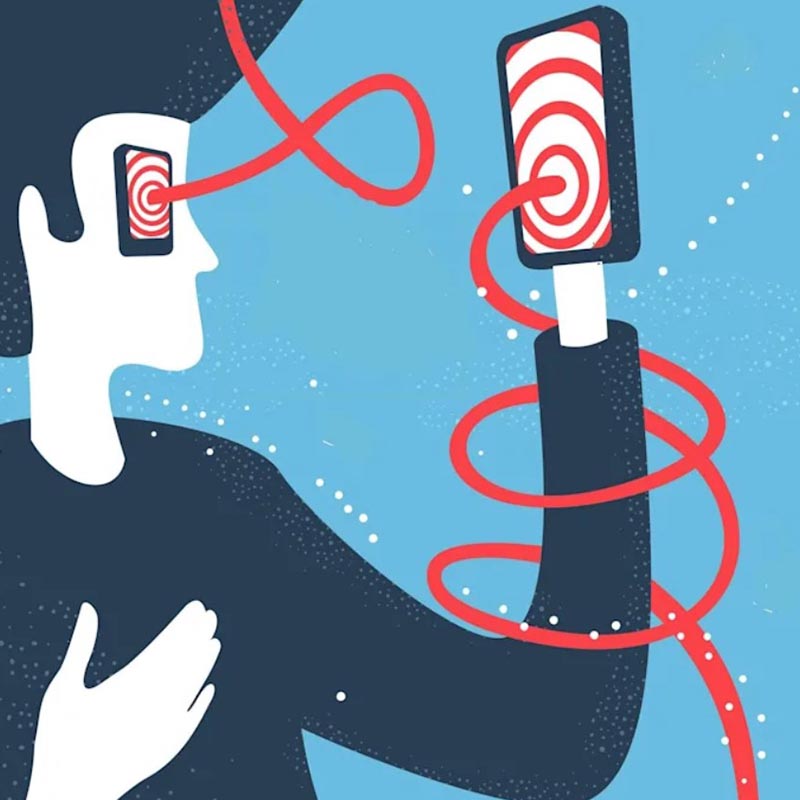
Cybersickness is a cluster of symptoms during the absence of physical motion, akin to motion sickness. These symptoms are categorized into nausea, oculomotor issues, and general disorientation. Oculomotor symptoms, including eye strain, fatigue, and headaches, involve stressing the nerve that controls eye movement. Disorientation can manifest as dizziness and vertigo. Meanwhile, several cybersickness symptoms overlap categories, such as difficulty concentrating and blurred vision. These issues can persist for several hours and may affect sleep quality.
People can experience the symptoms when using daily devices like computers, phones, and TV. In 2013, Apple introduced a parallax effect on iPhone lock screens that made the background image seem like it floated when a user moved their phone around. But, many people found it extremely uncomfortable. Surprisingly, the reason behind the discomfort is that it triggered cybersickness symptoms.
However, some researchers have different views about why people experience cybersickness. For instance, sensory conflict theory assumes that it is due to a mismatch of information sensed by our body parts that regulate vision and balance. Using every device can cause this conflict between visual perception and physical experience.
Cybersickness in Virtual and Augmented Reality
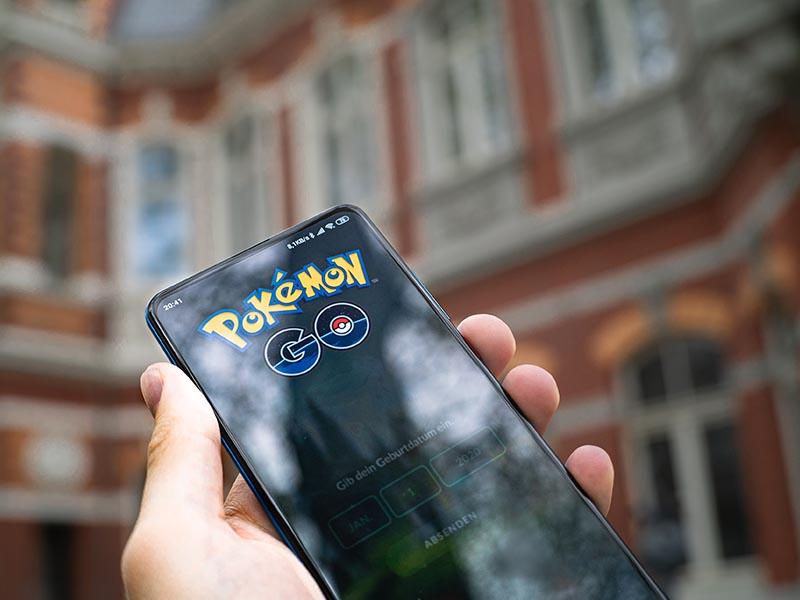
Cybersickness symptoms are perceived to become more intense with virtual reality (VR) and augmented reality (AR).
VR is widely available through popular gaming platforms like Facebook’s Oculus devices and Sony PlayStation VR. VR can trigger severe levels of nausea that increase with the duration of use. Also, this can cause some applications and games unusable for many individuals.
AR, on the other hand, are head-mounted devices that allow the user to see what’s in front of him. This includes games like Pokémon Go, accessible on your phone or tablet. Prolonged use of AR devices can result in more severe oculomotor fatigue.
A rise in the popularity of owning AR and VR devices can trigger an increase in cybersickness symptoms. Research and Markets estimate that adopting these technologies for various purposes may grow over 60 percent and reach USD 905.71 billion by 2027.
Cybersickness Symptoms Is Dangerous
While cybersickness symptoms may initially appear mild, they can have enduring effects over time. This may not seem like a big issue initially, but lingering symptoms may affect your ability to function well and could be dangerous. Symptoms such as severe headache, eye strain, or dizziness could affect your coordination and attention. If these symptoms persist while driving, it could lead to a car accident.
How to Deal With Cybersickness

If you are experiencing cybersickness symptoms, there are a few ways to ease the discomfort.
- Use blue light glasses to block out some of the blue light waves on your device screen.
- Zoom in your device screen or use larger font sizes to lessen eye strain and make daily work more sustainable and productive.
- Adjust devices visually, so your eyes are as comfortable as possible.
- Use devices in open spaces to reduce the risk of getting injured if you get dizzy and lose your balance.
- Take a short break if you start to feel any discomfort.
Proper Use of New Technology
The work-from-home trend has grown as a result of the COVID-19 pandemic. Commuting to work at an office setup was replaced with staying at home and enduring endless Zoom meetings. Even though the convenience is undeniable, it has also come with an increasing awareness of how hard it can be to look at a screen for over 40 hours per week.
However, don’t let cybersickness affect your motivation. As researchers continue to find ways to address cybersickness across all devices, people may be able to enjoy advancements in innovative technologies in the future without feeling uncomfortable.

Oppo Air Glass: A Ground-Breaking AR Technology Experiment?

Augmented Reality Contact Lenses: A Breakthrough in AR

What Is Cybersickness And How To Deal With It

10 Trusted Customer Feedback Tools Used by Many Businesses

10 Popular Competitor Research Tools To Stay Ahead of the Game

Top 10 Recruiting Tools Business Owners Should Know About

Level Up Your Marketing with These 10 Content Marketing Tools

Augmented Reality Contact Lenses: A Breakthrough in AR
10 Affiliate Tracking Software Tools to Grow Your Online Income

10 Audience Research Tools to Help You Understand Your Market

These Anti-MLM Communities Are Saving People from Scams

10 Trusted Customer Feedback Tools Used by Many Businesses

What Is Cybersickness And How To Deal With It


